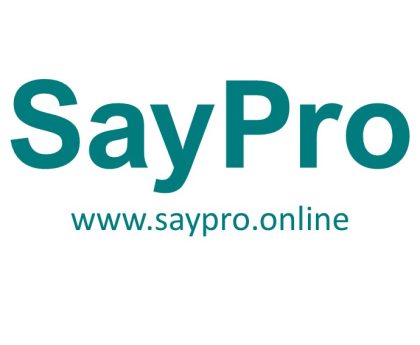SayPro Performance Analytics and Reporting Use analytics tools (such as Facebook Insights, Google Analytics, and others) to track the success of social media campaigns and website traffic from SayPro Monthly January SCMR-17 SayPro Quarterly Social Media Integration by SayPro Online Marketplace Office under SayPro Marketing Royalty
Objective:
To leverage analytics tools such as Facebook Insights, Google Analytics, and other relevant platforms to effectively measure and report on the performance of SayPro’s social media campaigns and website traffic. By continuously monitoring key metrics, the team can optimize campaigns, improve engagement, and drive conversions on SayPro’s online marketplace.
1. Setting Up Analytics Tools
A. Google Analytics Setup
Ensure that Google Analytics is properly integrated with SayPro’s website to track key performance metrics related to traffic, user behavior, and conversions:
- Tracking Code Integration: Verify that the Google Analytics tracking code is properly installed across all pages of SayPro’s website.
- Goals and Conversions Setup: Define conversion goals such as product purchases, form submissions, newsletter sign-ups, etc., and set them up in Google Analytics.
- E-commerce Tracking: If relevant, enable e-commerce tracking to monitor product sales, average order values, and revenue generated from social media campaigns.
B. Facebook Insights
Connect SayPro’s Facebook page to Facebook Insights to monitor the performance of paid and organic campaigns on the platform:
- Page Insights: Track engagement, reach, and audience demographics for posts on SayPro’s Facebook page.
- Ad Performance: Analyze the performance of Facebook ads, including metrics such as CPC (Cost Per Click), CTR (Click-Through Rate), conversion rates, and ROAS (Return on Ad Spend).
C. Other Relevant Social Media Analytics Tools
Use additional social media platform analytics tools to track the success of campaigns on platforms like Instagram, LinkedIn, and Twitter:
- Instagram Insights: Measure engagement, impressions, and interactions with posts, stories, and ads on Instagram.
- Twitter Analytics: Monitor tweet performance, follower growth, and engagement metrics on Twitter.
- LinkedIn Analytics: Track engagement on LinkedIn posts, articles, and sponsored content.
2. Monitoring Key Performance Indicators (KPIs)
A. Traffic Metrics
Track how social media campaigns impact website traffic and user behavior through the following metrics:
- Sessions: Measure the number of visits to SayPro’s website driven by social media campaigns.
- Referral Traffic: Identify the specific social media platforms that are driving the most traffic to the website.
- Bounce Rate: Analyze the bounce rate of visitors coming from social media platforms to understand if the landing pages are engaging and relevant.
- Pages per Session: Track how many pages users view during their visit to SayPro’s website, indicating user interest and engagement.
B. Engagement Metrics
Evaluate social media engagement to understand how well SayPro’s audience is interacting with posts and ads:
- Likes, Comments, Shares: Track engagement on organic posts and paid ads, indicating how well the content resonates with the audience.
- Social Shares: Monitor how often content is shared by users, which helps increase brand visibility.
- Click-Through Rate (CTR): Measure the percentage of people who clicked on a link within a post or ad, helping assess the effectiveness of CTAs.
C. Conversion Metrics
Monitor conversions and sales driven by social media traffic:
- Conversions: Track the number of specific actions taken on the website, such as product purchases, sign-ups, or downloads.
- Cost per Acquisition (CPA): Measure the cost of acquiring each new customer or lead from social media ads.
- Revenue/ROAS: Calculate the revenue generated from social media campaigns and evaluate the return on ad spend.
D. Audience Demographics
Monitor the demographics of the audience engaging with SayPro’s social media content to ensure it aligns with the target market:
- Age, Gender, Location: Track these key metrics to refine targeting in future campaigns.
- Interests and Behavior: Understand users’ interests and behaviors to tailor content and campaigns more effectively.
3. Reporting on Campaign Performance
A. Weekly and Monthly Reporting
Generate regular reports to track ongoing campaign performance and make data-driven decisions:
- Weekly Reports: A quick overview of ad performance, social media metrics, and website traffic. Identify any immediate changes or optimizations needed.
- Monthly Reports: A more comprehensive analysis of campaign performance across all social media platforms, traffic growth, conversion rates, and ROI. Identify trends and patterns, and provide insights on what worked well and areas for improvement.
B. Comprehensive Quarterly Reports
Develop in-depth quarterly reports to evaluate the success of social media campaigns over an extended period:
- Campaign Summary: A summary of all key campaigns, including objectives, metrics, and results.
- Traffic Growth: Analyze organic and paid social media traffic trends, including total sessions, bounce rate, and pages per session.
- Engagement Metrics: Track changes in engagement rates, including likes, shares, comments, and CTR.
- Conversions and Sales: Report on the number of conversions, revenue generated, and overall performance in terms of sales from social media channels.
4. Analyzing Social Media ROI
A. Tracking ROI from Social Media Campaigns
Measure the financial impact of social media campaigns to ensure SayPro is achieving a positive return on investment (ROI):
- Revenue vs. Ad Spend: Compare the revenue generated from social media campaigns against the total advertising spend to assess profitability.
- Customer Lifetime Value (CLV): For businesses with repeat customers, analyze the potential long-term value of customers acquired through social media campaigns.
B. Adjusting Strategies Based on Data Insights
Leverage insights gained from analytics to adjust strategies and optimize future campaigns:
- Optimize Ad Spend: Reallocate budgets to the highest-performing campaigns or platforms, ensuring efficient use of marketing dollars.
- Content Refinement: Refine content strategies based on which types of posts, visuals, or messaging generated the most engagement and conversions.
- Targeting Adjustments: Adjust audience targeting based on demographic and behavioral insights to reach the most relevant users.
- Optimize Landing Pages: If a high CTR isn’t converting to sales, assess and optimize landing pages for better user experience and higher conversion rates.
5. Using Social Listening for Campaign Insights
A. Social Listening Tools
In addition to direct analytics tools, use social listening platforms to track brand mentions, customer sentiment, and industry trends:
- Monitor Brand Mentions: Use tools like Hootsuite or Sprout Social to track when SayPro is mentioned on social media, helping identify opportunities to engage with users or address concerns.
- Sentiment Analysis: Analyze the tone of conversations around SayPro’s campaigns and products to assess customer sentiment.
- Competitive Insights: Monitor competitors’ social media campaigns and performance to identify opportunities for improvement and differentiation.
6. Optimizing Campaigns Based on Data
A. Continuous Optimization
Regularly analyze data to optimize social media campaigns in real-time:
- Creative Adjustments: Refine ad creatives based on performance insights to improve engagement and conversions.
- Targeting Tweaks: Adjust audience targeting based on what segments perform best in terms of engagement and conversions.
- Budget Adjustments: Allocate more budget to high-performing ads or platforms to maximize campaign impact.
Conclusion
By effectively utilizing analytics tools like Google Analytics, Facebook Insights, and other social media platforms, SayPro can track and measure the success of its social media campaigns and website traffic. Regular monitoring of key metrics such as traffic, engagement, conversions, and ROI allows SayPro to refine strategies, optimize campaigns, and ensure that marketing dollars are being spent effectively. Through data-driven decision-making, SayPro can continuously improve its social media performance, boost engagement with target audiences, and drive sales and conversions.



